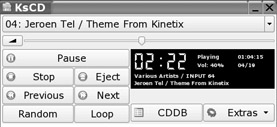Playing Audio CDs
SUSE Linux uses the KsCD application to play audio CDs. Once again, if you've ever used practically any CD-playing application under Windows, then you'll know what to expect, because KsCD offers similar functions.
To start KsCD, select K menu ® Multimedia ® CD Player. When the program has started, it will instantly minimize to the system tray. Once you insert an audio CD, KsCD will go into action and start playing the CD automatically. You can access its controls by double-clicking its icon, although you can also right-click the icon to gain quick access to the most commonly used controls.
| Note | KsCD plays CDs using the analog link from your CD/DVD-ROM drive to your PC's motherboard. In other words, it doesn't play CDs digitally by grabbing the data using the IDE cable, as Windows sometimes does. On most PCs, this won't be an issue, because the analog link is nearly always set up by the PC manufacturer, but if you've built your own PC, you'll need to make sure this cable is in place. |
KsCD is fairly simple to use, and its main buttons are clearly labeled. It's important to note that Linux tends to lock the CD/DVD drive when it's in use, so if you want to eject a disc, you'll need to use the Eject button on KsCD's interface, rather than the button on the front of the drive (it's also possible to unmount the CD from the shell, as described in Chapter 15).
One handy feature of the player is its CDDB support. As noted earlier, CDDB is an online database of CDs, complete with track and artist information. By clicking the CDDB button on the interface, you can automatically search this database and fill in the information in the KsCD playlist (provided you're online, of course), as shown in Figure 19-6. If the CD isn't found, which is rare, you can type in the information yourself. When you click the Submit button, this information will then be added to the main CDDB database for others to use. The track information for any CDs you look up in this way, or for whose details you enter, will then be held on your hard disk for future reference when you play the CD.

Figure 19-6. KsCD can look up the names of your CD tracks online.
Altering the volume of CD playback differs from altering the volume of MP3/Ogg playback. Instead of clicking and dragging the PCM slider in KAMix, you must click the Ext Source Playback tab, and then click and drag the CD sliders instead.
Note that once it's activated, KsCD will always appear in the system tray every time you reboot. This can have an unfortunate effect: if your PC boots up and an audio CD is in the drive, it will be played as soon as the desktop appears. You can avoid this by right-clicking the KsCD icon and selecting Quit. This will end the program and also stop it from starting whenever the computer boots.
EAN: 2147483647
Pages: 293